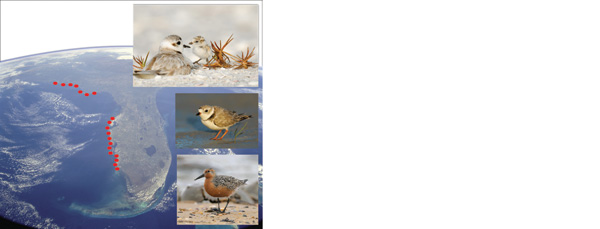Extracts

Tiny Shorebirds Benefit From Big Storms
Tiny threatened shorebirds on Florida’s west coast not only survive hurricanes, they seem to benefit from the storms’ after effects, according to new research findings that contradict conventional wisdom.
The findings could have implications for beach nourishment efforts throughout the world and how they affect wildlife.
A paper published in January by the online biology journal PLoS ONE outlines the University of Florida and Florida State University scientists’ findings that in the year following “tropical cyclones” — a term that covers hurricanes, tropical storms and tropical depressions — snowy plovers were seven times as likely to nest in affected coastal areas.
Matteo Convertino, a research associate in agricultural and biological engineering, said the U.S. Department of Defense funded the study as part of an overall effort to track its environmental impact on Florida Gulf Coast military installations and Eglin Air Force base, in particular.
The snowy plover, a white-chested bird with brown and black markings, is considered a threatened species, according to the Florida Fish and Wildlife Conservation Commission. In Florida, the birds are found along the state’s Gulf coast.
The scientists believe plovers benefit from the storms because wind and wave actions create changes to the shore, beach and dunes that the birds prefer when they look for nesting sites, said Convertino of UF’s Institute of Food and Agricultural Sciences.
Convertino said he was examining bird-count data from 2002 through 2010 for three regions along Florida’s west coast when he noticed an apparent increase in the birds’ abundance in years following tropical cyclones.
“The thought we had (earlier) was completely wrong. Hurricanes influence the shorebirds, but in a very positive way. And this goes against many other studies that just assumed a catastrophic event for the species,” he said.
James Elsner, an FSU geography professor and a co-author of the study, said the findings may help decision-makers understand how expensive beach nourishment programs actually affect threatened species, such as plovers.
“I think it’s a first step … but we have to understand what it is about hurricanes that refreshes the sand, because there is obviously some kind of renourishment (from storms) that doesn’t seem to occur when using the dredging methods,” he said.
Elsner, who studies hurricanes in a changing climate, said the shorebirds study demonstrates why he finds the subject so compelling.
“I think it’s interesting that there are a lot of potential impacts from climate change and that some of those impacts may surprise us — and this is one of them,” he said.
But the scientists say future climate change scenarios may not bode well for the birds or humans, as they predict fewer, but more powerful, storm events.